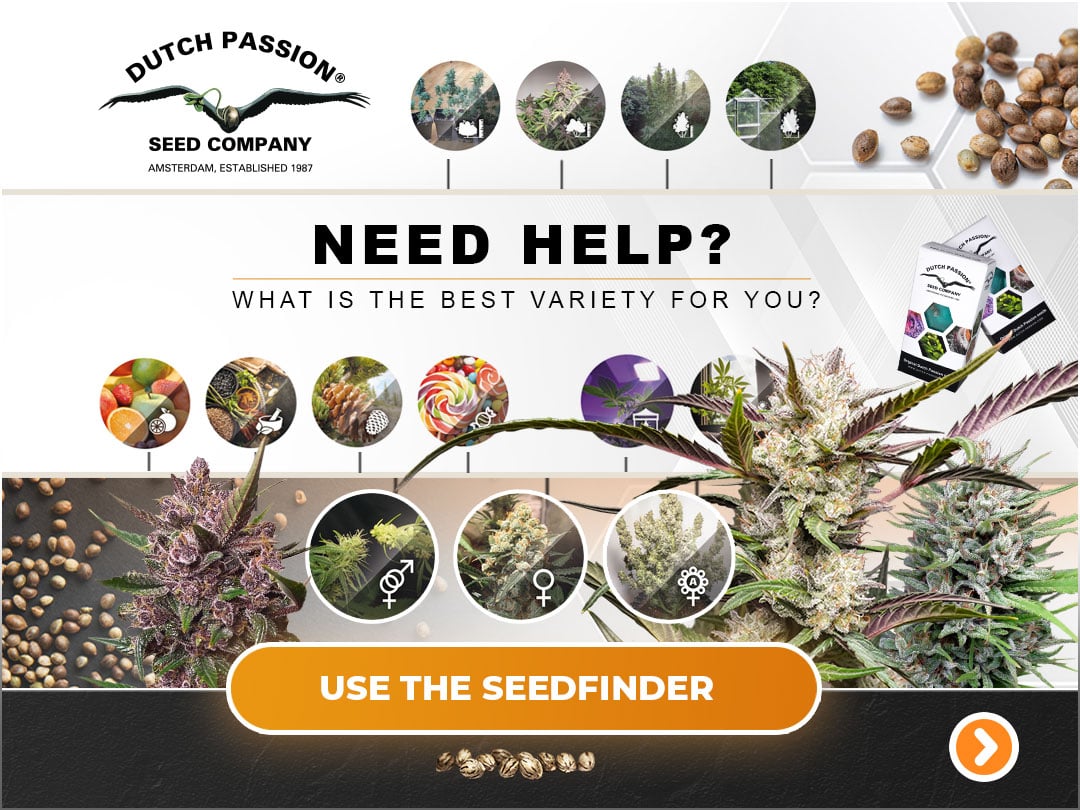Understanding the cannabis ripening process

An optimised cannabis ripening process can be the difference between an average harvest and a spectacular one bursting with cannabinoids and a mouthwatering terpene profile. You wouldn’t want to eat a banana or pear that hasn't been properly ripened, why would you settle for cannabis that hasn’t been correctly cultivated before it was harvested? Read on for some expert tips and professional advice to improve the quality of your cannabis harvest.
What does cannabis ripening mean?

After cannabis has grown through the seedling stage and vegetative stage comes the flowering (or bloom) phase where cannabis ripens. From start to finish, bloom typically takes around 9-10 weeks when growing photoperiod feminised cannabis seeds. But some fast indica strains can be ready to harvest in as little as 7-8 weeks of bloom. Conversely, some long blooming photoperiod Sativa/Haze strains can take 13 weeks (or more) until they are ripe enough for an optimised harvest
As bloom begins you will notice white hairs, commonly called pistils, emerging from small calyx’s on the plant. The buds will grow in number as flowering progresses. During early bloom, (whether growing autoflowering cannabis seeds or feminised seeds) your plants will stretch for a couple of weeks. Sativa strains can double, or even triple, their height during bloom whereas indicas may only add 25-50% to their height.
As harvest approaches the best cannabis genetics produce long, lavish blooms. Branches may bend under the weight of their own buds. The terpene profile should increase with an array of tempting aromas and you should see a lavish coating of trichomes. Both the terpene profile and the trichome appearance may change as harvest approaches.
Although cannabis ripening for the male cannabis plant is rarely discussed, males do stretch more and tend to grow even taller than females. This allows them to shed their pollen over the females giving pollination a greater chance of success.
| Related: |
| How to harvest dry and cure cannabis |
How to master the art of picking ripe cannabis buds

The first question to ask is whether you have a strong preference about when your buds are harvested. Some prefer to pick buds a week or so ahead of schedule. Your plants may still be producing white pistils. Trichomes may all be clear with no hints of cloudiness. Yield and potency may not yet be at their peak but some adore the energetic effects and the chance for a fast harvest.
Most growers tend to view optimum cannabis ripeness as the point where the trichomes are mainly cloudy. Pistils may be mostly red/orange at this stage and the buds may have a general feeling of ‘ripeness’ to the experienced eye.
A sizeable number of growers enjoy shooting for maximum yield and leave their plants for a week or two beyond what might be typically regarded as ‘normal’. The weed may feel like it has an extra heavy effect, more sedating and possibly stronger than at any other point. If you’re not sure how you like your buds, it’s well worth harvesting some at different stages on your next grow and comparing the effects.
The stages of a ripening cannabis bud in pictures
Cannabis bud ripening, weeks 1-3

White hairs, typically called pistils (but perhaps more accurately could be called stigmas) can be seen emerging from bloom points (calyx’s) on the plant. Initially there are small numbers of bloom points. These may form at the intersection of the stem/branch and leaves. Sativa cannabis strains in particular will stretch at this stage and cannabis leaves may alternate on the stem rather than emerge at mirror-opposite positions.
Cannabis bud ripening weeks 4-6

Your cannabis plant will be in full flowering with numerous buds present. Stretch may have slowed/stopped and the plant will be focussing much of her energy on swelling the buds and producing resin. You will see skinny-looking immature blooms, though they will be gaining weight each day. Trichome production should also be happening and your plants may well be pushing out some penetrating aromas.
Cannabis bud ripening weeks 7-9

The end game arrives! For most, but not necessarily all, cannabis strains harvest is rapidly approaching. In the absence of pollination, all the plants biochemical reserves are focussed on producing more buds, resin, terpenes and THC. The terpene profile reaches maximum pungency around harvest time. Many connoisseur growers note subtle differences in the aroma as it evolves. Some strains will require additional weeks to complete ripening, but many photoperiod feminised strains will be ready after around 9 weeks of bloom.
Autoflower strains approach harvest in much the same way even if the cannabis light cycle is different to that of photoperiod strains. As harvest approaches the autoflower buds will be near maximum yield and maximum potency. Auto strains typically reach harvest around 75 days after autoflower seed germination. But, as with photoperiod feminised strains, some autoflower strains will take longer than others to fully ripen and some may be faster.
Beware of overripe cannabis buds

Many modern growers enjoy leaving their cannabis buds to ripen for a week or two longer than the seed banks ‘typical’ harvest recommendations. The result may be buds with a heavier, more sedating effects and perhaps a weightier harvest. But it can be a fine line between ripe/mature buds and those which are perhaps a little over-ripe.
Plants given a little too much bloom time may have a general appearance of overripeness. Trichomes may be all amber, the terpene profile may be past it’s best (possibly with a light aroma of fermentation) and the buds/leaves may take on a browner, less inviting, appearance. To the experienced grower this will look like the buds have gone past their best.
Again, it’s good advice to know your own personal preferences when it comes to optimised bud harvest timings. If you haven't done so before, consider harvesting buds early, late and at the ‘average’ harvest point. Compare and contrast. You may discover that you are particularly fond of buds harvested at a particular stage of ripeness. Remember, one of the great benefits of home growing your own cannabis is that you determine the cannabis genetics, how they are grown and when they are harvested.
The stages of ripening cannabis trichomes
Most serious growers have a magnifying glass/lens to examine the trichome appearance around harvest point. Trichomes contain cannabinoids and terpenes, so closely monitoring them can tell you precisely how the cannabis ripening process is progressing. This dedicated review of cannabis trichomes and the science behind them will be enjoyable reading for those interested to know more.
| Related: |
| Cannabis trichomes - all you need to know |
Immature trichomes (buds not quite ripe enough for most growers)

Immature trichomes will be clear and colourless. They appear in small numbers early in growth and increase in density/size as bloom progresses. The first hint of cloudiness/milkiness is a sign that the plant is approaching the typical harvest point. A minority of growers enjoy harvesting their buds early for an energetic, cerebral effect. However yields are probably below their peak and cannabinoid/terpene production may not yet have maxed out.
Mature trichomes (ripe buds - for most growers these are ready to harvest)

As the cannabis plant approaches optimum ripeness the grower often looks for the trichome appearance to have changed from ‘mostly clear’ to ‘mostly cloudy’. At this stage there may well be a few amber trichomes appearing as well as a few clear/colourless trichomes remaining. For many this is a good balance and an optimum stage of ripeness. The effects will be powerful, stimulating and satisfying but perhaps not as heavy and sedating as late-harvested buds.
Overripe trichomes (well ripened cannabis buds are preferred by some)

Some growers like to wait until the trichome appearance has changed from mostly cloudy to mainly amber. This has the benefit of allowing the plant an extra week (or two) of bloom which may well mean a heavier harvest. The buds will often deliver a heavier, more powerful effect - perfect perhaps for a late night vape or a lazy night on the sofa with a well-stocked fridge. If you don't mind waiting a couple of weeks extra for your harvest and enjoy a weightier effect then a few over-ripe trichomes on your buds may well be something worth considering.
Best cannabis buds ripening techniques

Most professional, licensed cannabis growers are aware that LED lighting will produce better quality buds and contribute to a superior ripening process with improved cannabinoid and terpene levels. Many expert cannabis growers would say that understanding how to optimise terpene levels is one of the most important aspects of cannabis cultivation. It’s one area where expert advice can really help the average grower step-up quality levels and produce perfectly ripened buds. The following guide summarises how the pro-growers optimise terpene levels.
| Related: |
| How to increase terpene levels in cannabis plants |
All serious growers will also talk of the critical importance of keeping the plants in the nutrient and optical ‘sweet spot’ without over/under feeding and without excessive/insufficient light levels.
Indoors:
The indoor grower has maximum control over the environment. The astute and experienced grower uses this to maximum advantage and will attempt to optimise all the environmental conditions. Ensuring low humidity levels as bloom approaches minimises the chance of mold/rot taking hold. This is one way the indoor grower can fine-tune their cannabis ripening conditions and minimise chances of problems. The indoor grower can also increase light levels to the max as harvest nears as well as controlling the temperatures correctly.
| Related: |
| All you need to know about PAR, PPFD, Wattage and DLI |

Some indoor growers deliberately introduce cool temperatures in the week before harvest to produce a stunning display of autumnal colours. They may also complement their quality LED lighting with UVA/UVB supplementation which can increase terpenes and cannabinoids to deliver perfectly ripened buds. If you want to read more about the cannabis bloom phase and how you can control it to deliver perfectly ripened cannabis buds then the following article will be helpful.
| Related: |
| Cannabis flowering stage how-to guide |
When it comes to nutrient management there are different schools of thought. Some flush their cannabis plants (feeding only with plain water) whereas others feed their plants to the end with bloom nutrients and bloom enhancers/bud sweeteners. If you want to read an in-depth analysis about the pros and cons of cannabis flushing, the following blog is essential reading and may surprise you.
| Related: |
| How to flush cannabis correctly |
Outdoors:
The outdoor cannabis grower isn't afforded the same control over their environment as the indoor grower. But that doesn't mean that the outdoor grower has no options at all. The starting point for the outdoor grower is a proven outdoor strain that will cope well with the climatic conditions at your latitude/location. Starting with the best outdoor cannabis seeds substantially increases your chances of pulling off a killer harvest of beautifully ripened buds. 
The outdoor grower can also consider optimising the soil before the grow begins and supporting their plant with bloom nutrients during flowering. In borderline climates you may wish to consider a shelter to protect the outdoor plants from the worst of the late-season weather, e.g. a tarpaulin sheet. Good preparation and forward-planning are great companions for the outdoor grower, as is a firm knowledge of local weather patterns.
Outdoor growing in the UK is often difficult with unpredictable weather. The following article on UK outdoor growing is useful reading for anyone considering an outdoor cannabis grow in challenging conditions.
| Related: |
| How to grow cannabis outdoors in the UK |
Cannabis ripening FAQ
Achieving perfectly ripened cannabis buds is about optimising several different areas of cultivation. The experienced grower benefits from the accumulated knowledge gathered over many years of gardening. Growing the best cannabis genetics ensures you maximise your chances of connoisseur quality buds. But growing them well and ensuring optimised plant health and optimised environmental conditions throughout the grow is also required. As is a steady hand in the last few weeks before harvest. Remember to complete the job with a careful curing at the end. Perfectly ripened buds can't be rushed!
What does shock ripening mean in cannabis?

Shock ripening can mean slightly different things to different people. Typically shock ripening means leaving plants in the dark for the last 3 days or so before harvest. The belief is that is encourages resin production, though not everyone subscribes to the theory. To other growers, shock ripening means watering plants with icy water just before harvest to produce a stunning display of red/blue colours on the buds and foliage. For commercial growers, this may increase the crop value.
Can you force cannabis buds to ripen?
A cannabis plant grown from photoperiod feminised cannabis seeds can be forced into bloom indoors by reducing the number of daily light hours to around 12. If you are growing cannabis in a greenhouse the use of special ‘darkening blinds’ can be used to force the plants to begin bloom before they would have done naturally.
How can I make my buds ripen faster?
It’s difficult to suggest short cuts to a process that nature ultimately dictates. Each cannabis plant phenotype will take her own time required to complete the bloom process. As the grower, your job is to ensure the conditions, lighting, nutrition and environment is optimised. Be patient, and allow the buds to ripen slowly under the perfect conditions which you provide.
Can light intensity affect cannabis ripening times?
Light intensity affects yields rather than ripening times. But light quality will influence the final standard of your cured and ripened cannabis buds. That’s why many quality-focussed growers prefer to use LED grow lights rather than HPS. LED growers tend to produce buds with higher THC and terpene levels.
Does red light cause early cannabis ripening?
Red light in general supports heavy bud and resin production. Far red light is thought to be able to reduce bloom time, perhaps by 10-15%. Far red light isn't photosynthetically active, the wavelengths are 700-750nm. But far red is present in sunlight. The use of far-red is known as the Emerson effect, though many claim the full mechanism isn't completely understood.
Why are my buds taking forever to mature?
It could be that you have a slow blooming phenotype which simply requires a little more time. It could also be that your grow room has been cooler than optimum and plant development has slowed as a result. Check your conditions are as good as you can get them. If the environment is optimised you can do little else other than wait for the cannabis genetics to complete their work.

































Lola - Dutch Passion
2023-11-30 10:35:06
Bonjour Mahreche Fouzia 2023-09-24 13:38:01, ici vous pouvez en savoir plus sur le séchage : https://dutch-passion.com/fr/blog/les-meilleurs-methodes-pour-secher-et-affiner-le-cannabis-n918 J'espère que ça aide. :) Passe une bonne journée. Lola - Dutch Passion
Mahreche Fouzia
2023-09-24 13:38:01
Combien de temps de séchage une fois cultiver ? Faut t'il les mettre dans le noir ?
Canaman
2023-05-27 01:20:33
Stage 1 2 months 18 hrs a day light. Stage 2 2 months 12 hrs a day light Stage 3 3 months 8 hrs a day light. And mine are kicking. Watch though for that amber color on buds. That means it’s harvest time
Kriz
2022-11-07 03:07:53
"Far red light isn't photosynthetically active, the wavelengths are 700-750nm" A recent study by Dr. Bruce Bugbee shows photosythetic activity in far red up to 750nm, calls it even "a new standard".
Rodo
2022-10-20 02:33:51
Wonderfully info .. Ty
Lola - Dutch Passion
2022-10-06 12:59:34
Hello Gaston 2022-09-28 00:12:33 In certain genetics it's very common for buds to reflower on itself. It's like foxtailing new flowers on top of older ones. You should look at the main flower and bud, to tell when to harvest, because the plant will most likely keep developing new white haired flower parts. Google Translate: En ciertas genéticas es muy común que los cogollos vuelvan a florecer sobre sí mismos. Es como 'foxtailing', flores nuevas encima de las más viejas. Debe mirar la flor principal y los cogollos para saber cuándo cosechar, porque lo más probable es que la planta siga desarrollando nuevas partes de la flor de pelo blanco.
Beano
2022-10-02 20:16:34
If you live in a A northern cold climate zone, I have found a way to get plants to bud early. I start them in April from seeds, because I’m creating new strains, you could use cuttings. I start them under a fluorescent T5 light , Grow them to about 10 inches or three sets of leaves then turn the lights down and make them show their sex. I keep watch with a magnifying glass and as soon as they show male or female, I eliminate the males and then put the females in my greenhouse outdoors. As they are already slightly in bud mode, it takes a while to get back to the vegetative state and they don’t completely reach the vegetative state. This way the plants finish early but they are not as big. But you get completely ripe buds in the northern colder zones with very long days. I harvested my first plant this year yesterday and I live in Washington state. Normally it is not ready until the end of October and we can sometimes have a lot of rain and cold weather in October. My system works, I’ve used it the last two years with great results. Other than smaller plants, it works great. Just grow a few more plants. Just an idea
Gaston
2022-09-28 00:12:33
Hola tengo una duda, a mis cogollos ya maduros les esta saliendo pistilos blancos nuevos, como los que salen en pre floración pero dentro de los ya maduros
joshua coyle
2022-05-27 17:05:51
light intensity does effect ripening, ever notice side and lower budding sights at harvest? They look weeks behind the tops but crank up the light and they start ripening quite fast.